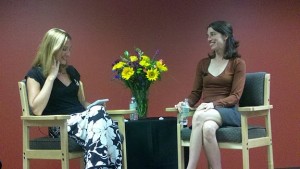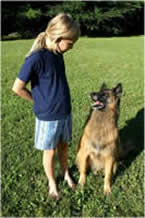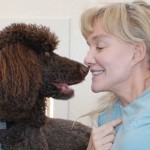I got lucky.
Lindsay Wood, the Director of Animal Training and Behavior at the Human Society of Boulder Valley (HSBV) (Read Lindsay’s bio here. She’s amazing!), has been observing and assisting Nan Arthur, our instructor, in the Karen Pryor Academy class in which Sadie and I are enrolled. Final assessments are today Monday, September 26. Yikes!
A few weeks ago I signed up too late to attend a very special HSBV event: Lindsay interviewing her beloved mentor, Alexandra Horowitz of Inside of A Dog: What Dogs See, Smell, and Know fame, in the style of James Lipton of Inside the Actors Studio, another favorite.
I was wait-listed. Not surprisingly the event filled to capacity in a matter of hours of it being announced.
I heard Alexandra speak for the first time last year at APDT in Atlanta. I didn’t want her to stop talking. She’s eloquent, evocative, charming, empathic, and very, very smart. (Alexandra’s currently a professor at Barnard College. Read about her and her work at the Canine Cognition Lab here.)
During lunch at the previous week-end KPA class that preceded the interview by a few days, Lindsay fretted about what questions to ask and how to ask them. While I understood her stage fright, I knew Lindsay had nothing to worry about. She’s one of the most poised women I’ve ever met.
I dissed myself for dilly-dallying instead of registering.
Then manna landed in my inbox. At the last minute, someone cancelled and I was next in line. I accepted the invitation and hit ‘reply.’
I arrived early to attend a reception in Alexandra’s honor where I enjoyed champagne and a dash of dishing about the dog world with Roxanne Hawn and Hilary Lane, two blogging buddies I hadn’t seen in ages.
Lindsay and Alexandra were delightful together–mutually admiring student and professor, sharing thoughts and reflections about the love of their lives—dogs. The interview was pitch-perfect.
The easy ebb and flow of their conversation carried me along. Then, over halfway through the interview, I had a V-8 moment. I could have been blogging about this!
I’ve been so out of blogging mode since the beginning of the KPA course in May, I forgot to take my laptop. I didn’t even have a pen. I had to borrow one in order to write a few notes in the margins of the program.
Let’s begin at the end. You might be familiar with James Lipton’s now famous ten questions with which he concludes every interview. Lindsay did the same with Alexandra. Unfortunately, I remember only two of the questions—Alexandra’s answer to the first one is Lindsay’s personal favorite. Alexandra’s reply to the second one is mine.
“What is your favorite word?”
“Pumpernickel.”
Pumpernickel, or Pump for short, was Alexandra’s dog who lovingly graced many pages in Inside of a Dog.
“What is your favorite sound?”
“My dog snuffling as he smells my face when I come home.”
It doesn’t get more onomatopoetic than that. I wish Sadie was a snuffler, but, alas, she is not.
Lipton doesn’t ask this question, but I’m glad Lindsay did: What is the biggest fallacy in our understanding of dogs?
“That dogs form hierarchical packs and you need to be on top.”
On dogs having a theory of mind:
Alexandra watched hours of dogs at play in slow motion (30 frames per second) for her dissertation.
“Dogs do just enough attention getting behavior to get the attention of the other dog. They match their attention getting behavior to the status of the other dog.”
“What a dog is communicating to another dog, and what the other dog seems to understand: ‘Whatever I say is untrue because I just did a play-bow, so if I bite or growl, it’s just play. I didn’t really mean it.’”
In research with Marc Bekoff, she identified “atmospheric” cues between dogs. “Dogs do a play-bow before a hip slam. This suggests the dog is communicating to another mind, that of the other dog.”
For more on Alexandra’s thoughts on dogs having a theory of mind and her critique of the research I wrote about in the previous two blog posts – here and here – read this by Alexandra, “Theory of Mind in Dogs? Examining method and concept.”
On anthropomorphisms:
“We should not reject anthropomorphisms out of hand, but consider them hypotheses worthy of investigation.” (See Alexandra’s research on the ‘guilty look’ here and “Naturalizing Anthropomorphism: Behavioral Prompts to Our Humanizing of Animals,” an article she co-authored with Marc Bekoff.)
My favorite quote:
“We need to be asking: What is the problem for my dog? Not: What is the problem for ME? Why is my dog not heeling on the left? Why does she keep going to the right? Maybe there are better smells on the right. Maybe the dog is right pawed. Just as with most people, most dogs have a preferred paw.”
Every time I listen to Alexandra speak, I’m left with this desire: I want what she has. I want to intelligently and empathically imagine myself into the inside of my dog.
Tags: Alexandra Horowitz, Anthropomorphism, Anthropomorphisms dogs, APDT Atlanta, Canine Cognition Lab, Dog behavior, dog play, Humane Society of Boulder Valley, Inside of a Dog, Inside the Actors Studio, Interview, Karen Pryor Academy, Lindsay Wood, Marc Bekoff, Nan Arthur, Theory of mind in dogs

















